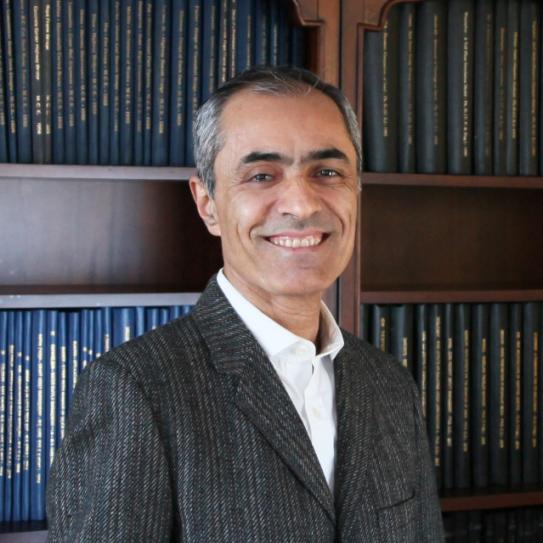
Masoud Ghandehari serves on the Faculty of Civil and Urban Engineering at the NYU Tandon School of Engineering and is an associate faculty at the NYU Center for Urban Science and Progress. His research focus is on urban systems engineering and the application of advanced instrumentation and data analysis targeting the aging, health and performance of infrastructure systems. Through the application of sensing, and modeling, he works on methodologies that generate data on the interaction of physical, natural and human systems in cities.His research in optical spectroscopy, sensing, imaging, and data analytics has led to the development of applications and technologies suitable for diverse environments and multiple scales; ranging from the molecular to the urban landscape. Professor Ghandehari is author of Optical Phenomenology and Applications: Health Monitoring for Infrastructure Materials and the Environment, 2018, the founding investigator of the New York State Resiliency Institute for Storm Events, and founder of Chromosense LLC., which is supported by the National Institutes of Health for innovation in environmental sensing.
Education
Columbia University 1988
Bachelor of Science, Civil Engineering & Applied Mechanics
McGill University 1993
Master of Science, Civil Engineering
Northwestern University 1998
Doctor of Philosophy, Civil and Environmental Engineering
Publications
Book: Optical Phenomenology and Applications: Health Monitoring for Infrastructure Materials and the Environment. Masoud Ghandehari, Springer 2018 Link
Journal Publications
Corresponding author (underlined), student co-author (asterisk)
- GHANDEHARI, M., EMIG, T. and AGHAMOHAMADNIA, M*., 2018. Surface temperatures in New York City: Geospatial data enables the accurate prediction of radiative heat transfer. NATURE Scientific Reports (Nature Publisher Group), 8, pp. 1-10. DOI
- YANG, L*., LI, W., GHANDEHARI, M. and FORTINO, G., 2018. People-Centric Cognitive Internet of Things for the Quantitative Analysis of Environmental Exposure. IEEE Internet of Things Journal, 5(4), pp. 2353-2366. DOI
- GHANDEHARI, M., AGHAMOHAMADNIA, M*., DOBLER, G., KARPF, A., BUCKLAND, K., QIAN, J. and KOONIN, S., 2017. Mapping Refrigerant Gases in the New York City Skyline. NATURE Scientific Reports (Nature Publisher Group), 7(1), pp. 2735. DOI
- JOHNSON, N.E*., IANIUK, O., CAZAP, D., LIU, L., STAROBIN, D., DOBLER, G. and GHANDEHARI, M., 2017. Patterns of waste generation: A gradient boosting model for short-term waste prediction in New York City. Waste Management, 62, pp. 3-11. DOI
- LIU, E*., GHANDEHARI, M., BRUCKNER, C., KHALIL, G., WORLINSKY, J., JIN, W., SIDELEV, A. and HYLAND, M.A., 2017. Mapping high pH levels in hydrated calcium silicates. Cement and Concrete Research, 95, pp. 232-239. DOI
- SIDELEV, A*. and GHANDEHARI, M., 2017. Quantitative Assessment of Subsurface Oxidation in Coated Materials. Journal of Performance of Constructed Facilities, 31(5). DOI
- GREGORY, D., MASOUD, G., STEVEN, E.K. and MOHIT, S.S*., 2016. A Hyperspectral Survey of New York City Lighting Technology. Sensors, 16(12), pp. 2047. DOI
- ZULLI, M., GHANDEHARI, M., SIDELEV, A*. and SHAH, S.P., 2016. Dimensional factors in oxidation induced fracture in reinforced concrete. Construction and Building Materials, 122, pp. 264-272. DOI
- ROSSO, F*., JIN, W., PISELLO, A.L., FERRERO, M. and GHANDEHARI, M., 2016. Translucent marbles for building envelope applications: Weathering effects on surface lightness and finishing when exposed to simulated acid rain. Construction and Building Materials, 108, pp. 146-153. DOI
- ROSSO, F*., PISELLO, A., JIN, W., GHANDEHARI, M., COTANA, F. and FERRERO, M., 2016. Cool Marble Building Envelopes: The Effect of Aging on Energy Performance and Aesthetics. Sustainability, 8(8), pp. 753. DOI
- WILKE, E*., JIN, W., VAN DESSEL, S., BERARDI, U., GHANDEHARI, M., EL-KORCHI, T., NARAIN, J. and SHUKLA, N., 2016. Design and Application of Concrete Tiles Enhanced with Microencapsulated Phase-Change Material. Journal of Architectural Engineering, 22(1), pp. 5015003. DOI
- ZHENG, S*., GHANDEHARI, M. and OU, J., 2016. Photonic crystal fiber long-period grating absorption gas sensor based on a tunable erbium-doped fiber ring laser. Sensors & Actuators: B. Chemical, 223, pp. 324-332. DOI
- LEUNG, C.K.Y., WAN, K.T., INAUDI, D., BAO, X., HABEL, W., ZHOU, Z., OU, J., GHANDEHARI, M., WU, H.C. and IMAI, M., 2015. Review: optical fiber sensors for civil engineering applications. Materials and Structures, 48(4), pp. 871-906. DOI
- WORLINSKY, J.L*., HALEPAS, S*., GHANDEHARI, M., KHALIL, G. and BRÜCKNER, C., 2015. High pH sensing with water-soluble porpholactone derivatives and their incorporation into a Nafion® optode membrane. The Analyst, 140(1), pp. 190-196. DOI
- ZHENG, S*., SHAN, B., GHANDEHARI, M. and OU, J., 2015. Sensitivity characterization of cladding modes in long-period gratings photonic crystal fiber for structural health monitoring. Measurement, 72, pp. 43-51. DOI
- DOBLER, G., GHANDEHARI, M., KOONIN, S.E., NAZARI, R., PATRINOS, A., SHARMA*, M.S., TAFVIZI, A., VO, H.T.1. and WURTELE, J.S., 2015. Dynamics of the urban lightscape. DOI
- KLAVARIOTI, M*., KOSTARELOS, K., POURJABBAR, A. and GHANDEHARI, M., 2014. In situ sensing of subsurface contamination—part I: near-infrared spectral characterization of alkanes, aromatics, and chlorinated hydrocarbons. Environmental Science and Pollution Research, 21(9), pp. 5849-5860. DOI
- WORLINSKY, J.L*., ZARATE, G., ZELLER, M., GHANDEHARI, M., KHALIL, G. and BRÜCKNER, C., 2013. Oxazolochlorins 11: Tuning the dynamic high pH sensing range of meso-tetraarylporpholactonato]M(II) complexes by variation of the central metal ion, the aryl substituents, and introduction of a β-nitro group. Journal of Porphyrins and Phthalocyanines, 17(08), pp. 836-849. DOI
- GHANDEHARI, M., VIMER, C.S*., IOANNOU, I., SIDELEV, A., JIN, W. and SPELLANE, P., 2012. In-situ measurement of liquid phase moisture in cement mortar. NDT & E International, 45(1), pp. 162-168. DOI
- KHALIL, G.E., DADDARIO, P*., LAU, K.S.F*., IMTIAZ, S*., KING, M*., GOUTERMAN, M., SIDELEV, A*., PURAN, N*., GHANDEHARI, M. and BRÜCKNER, C., 2010. meso-Tetraarylporpholactones as high pH sensors. The Analyst, 135(8), pp. 2125. DOI
- VIMER, C*., YU, S*. and GHANDEHARI, M., 2009. Probing pH Levels in Civil Engineering Materials. Journal of Materials in Civil Engineering, 21(2), pp. 51-57. DOI
- KHALIL, G.E., KIMURA, F., CHIN, A., GHANDEHARI, M., WAN, R., SHINOKI, W., GOUTERMAN, M., CALLIS, J.B. and DALTON, L.R., 2006. Continuous Underground Monitoring of Gas Leaks. Research in Nondestructive Evaluation, 16(3), pp. 119-130. DOI
- GHANDEHARI, M. and KHALIL, G., 2005. Materials Health Management by In-Situ Chemical Analysis. ASNT Journal of Materials Evaluation, 63(7). DOI
- GHANDEHARI, M. and VIMER, C.S., 2004. In situ monitoring of pH level with fiber optic evanescent field spectroscopy. NDT & E International, 37(8), pp. 611-616. DOI
- AKKAYA, Y*., GHANDEHARI M, ACKERMAN B, SHAH S. Influence of Fiber Dispersion on the Performance of Microfiber Reinforced Composites. Fiber Reinforced Concrete: Innovations for Value. ACI Special Publication, Academy of Athens; 2002. DOI
- GHANDEHARI, M., KRISHNASWAMY, S. and SHAH, S., eds, 2001. Dimensional Factors of Bond Failure in Reinforced Concrete. ACI Special Publication SP-201 edn. ACI. DOI
- GHANDEHARI, M., KRISHNASWAMY, S. and SHAH, S., 2000. Bond-Induced Longitudinal Fracture in Reinforced Concrete. Journal of Applied Mechanics, 67(4), pp. 740. DOI
- POPOVIC, J., SONG, W., GHANDEHARI, M., SUBRAMANIAM, K., ACHENBACH, J. and SHAH, S., 2000. Application of Surface Wave Transmission Measurements for Crack Depth Determination in Concrete. American Concrete Institute Materials Journal, 97(2), pp. 127-135. DOI
- ALDEA, C., GHANDEHARI, M., SHAH, S. and KARR, A., 2000. Estimation of Water Flow Through Cracked Concrete Under Load. American Concrete Institute Materials Journal, 97(5), pp. 567-575. DOI
- PELED, A., ENSSLEN, F*., GHANDEHARI, M*. and SHAH, S., 1999. Pullout Resistance of Anchor Bolts: Effect of Matrix Properties. Concrete Science and Engineering, V1, pp. 120-128. DOI
- GHANDEHARI, M*., KRISHNASWAMY, S. and SHAH, S., 1999. Technique for Evaluating Kinematics between Rebar and Concrete. Journal of Engineering Mechanics, 125(2), pp. 234-241. DOI
Experience
New York University, Tandon School of Engineering
Department of Civil and Urban Engineering
Associate Professor
September 1999 to present
Center for Urban Science and Progress
Associate Faculty
January 2013 to present
Northwestern University
Post Doctoral Fellow
December 1998 to July 1999
Weidlinger Associates, New York
Engineer
April 1989 to June 1991
Geiger and Associates, New York
Engineer
June 1988 to April 1989
Patents
Method for Mapping Distribution of High pH, (Pending)
Technology for detection of hazardous substances, (Provisional)
Research News
A study on the association of socioeconomic and physical cofactors contributing to power restoration after Hurricane Maria
This research was led by Masoud Ghandehari, professor in the Department of Civil and Urban Engineering at NYU Tandon, with Shams Azad, a Ph.D. student under Ghandehari’s guidance.
The electric power infrastructure in Puerto Rico suffered substantial damage as Hurricane Maria crossed the island on September 20, 2017. Despite significant efforts made by authorities, it took almost a year to achieve near-complete power recovery. The electrical power failure contributed to the loss of life and the slow pace of disaster recovery. Hurricane Maria caused extensive damage to Puerto Rico’s power lines, leaving on average 80% of the distribution system out of order for months.
In this study, imagery of daily nighttime lights from space was used to measure the loss and restoration of electric power every day at 500-meter spatial resolution. The researchers monitored the island’s 889 county subdivisions for over eight months using Visible/Infrared Imagery and Radiometer Suite sensors — which showed how power was absent/present visually — and by formulating a regression model to identify the status of the power recovery effort.
The hurricane hit the island with its maximum strength at the point of landfall, which corresponds to massive destruction across all physical infrastructures, resulting in a longer recovery period. Indeed, the researchers found that every 50-kilometer increase in distance from the landfall corresponded to 30% fewer days without power. Road connectivity was a major issue for the restoration effort: areas having a direct connection with hi-speed roads recovered more quickly with 7% fewer outage days. Areas that were affected by moderate landslides needed 5.5%, and high landslide areas needed 11.4% more days to recover.
The researchers found that financially disadvantaged areas suffered more from the extended outage. For every 10% increase in population below the poverty line, there was a 2% increase in recovery time. While financial status did impact restoration efforts, the investigators did not find any additional association of race or ethnicity in the study.


